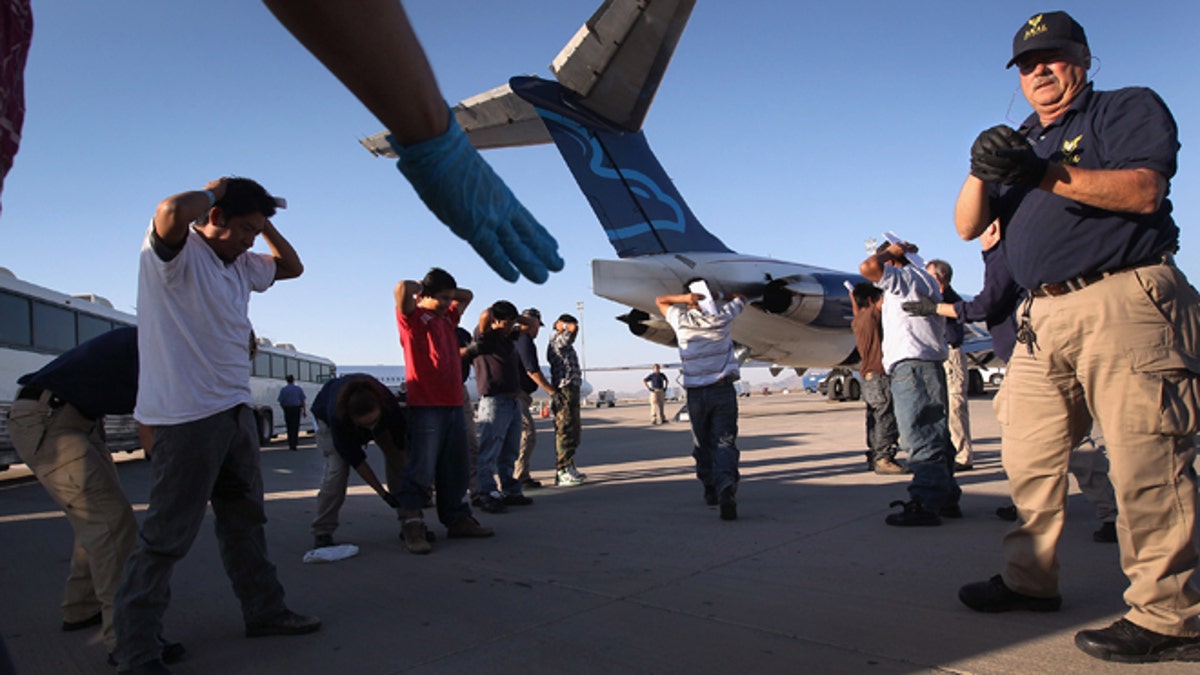
MESA, AZ - JUNE 24: Undocumented Guatemalan immigrants are body searched before boarding a deportation flight to Guatemala City, Guatemala at Phoenix-Mesa Gateway Airport on June 24, 2011 in Mesa, Arizona. The U.S. Immigration and Customs Enforcement agency, ICE, repatriates thousands of undocumented Guatemalans monthly, many of whom are caught in the controversial "Secure Communities" data-sharing program which puts local police on the frontlines of national immigration enforcement. ICE recently announced a set of adjustments to the federal program after many local communities and some states, including New York, insisted on opting out, saying immigrants were being deported for minor offenses such as traffic violations. Guatemala ranks only second to Mexico in the number of illegal immigrants deported from the United States. (Photo by John Moore/Getty Images) (2011 Getty Images)
As the tide of undocumented immigrants from Mexico is replaced by a growing surge from Central America, federal authorities in the United States are faced with the issue of returning home those migrants slated for deportation — now that "home" is a few thousand miles farther.
The Department of Homeland (DHS), the federal agency responsible for deporting undocumented immigrants, charters daily flights to return migrants to their home countries – but as the number of immigrants rises so have the number of flights … and the cost.
In its 2015 budget overview, the DHS has requested $229.1 million for the removal of undocumented immigrants alone — an amount that does not include housing and feeding them.
“When people look at the fiscal impact of immigration,” Marc Rosenblum, the Deputy Director of the Migration Policy Institute’s U.S. Immigration policy program told Fox News Latino. “This is one expensive slice of it.”
The DHS calls these flights from places like San Antonio and Miami an “innovative arrangement” that provides “ICE cost effective and highly flexible flight services,” but the prices laid out in the budget show that the 2013 cost of a flight per hour was more than $8,300 and has risen steadily since 2011.
The rise in flight costs and the number of flights – approximately one or two a day to countries like Guatemala and Honduras – has coincided with the rapid rise of Central Americans arriving in the United States, especially along Texas’ southern border.
While undocumented immigrants from Mexico still make up the largest segment of the population – peaking at 6.9 million in 2007 – their numbers have dropped in recent years thanks to stepped-up border enforcement in traditional hotspots like Arizona and California as well as rebounding Mexican economic situation.
“The Mexican economy has been relatively strong over the past few years,” Rosenblum said. “Also some migrants stopped coming to the U.S. when the recession in the U.S. hit.”
The decline in Mexican immigration has coincided with the rise of those from Central America, as U.S. Census data estimates that migrants from the region were the fastest growing segment of the Latin American immigrant population. The number of Central American-born immigrants living in the United States increased from 2.0 million to 3.1 million, a growth rate of 51 percent from 2000 to 2010.
Immigration hardliners argue that this spike in Central American migrants is due in part to the government’s alleged lax policies toward immigration, claiming that when they make it to the U.S. there is very little chance that an undocumented immigrant will be deported.
“This is a crisis that endures because of our country’s policies,” Ira Melhman, a spokesperson for the Federation of American Immigration reform (FAIR) told Fox News Latino. “We’re seeing a rational response to the message that the Obama administration is saying.”
Most Central Americans immigrants cite a surfeit of reasons why they have emigrated to the U.S., with the top motives being poverty, lack of job prospects and rampant violent crime in their home nations. But the reason that they leave the country is mainly deportation.
In Arizona alone, 18,493 Guatemalans have been deported so far during 2014, representing a 24 percent increase over the same period in 2013.
Along with the cost that these expatriation airlifts accrue for the federal government, the newly arrived deportees also present problems for the financially strained governments of Central America. Already struggling to deal with their own problems, the deported migrants, some tied to notorious gangs like MS-13 and Calle 18, continue to fuel the violent unrest in places like El Salvador and Honduras – and sending repercussions to the U.S.
MS-13 was founded by immigrants fleeing El Salvador's civil war more than two decades ago, building a reputation in the Los Angeles area and in other regions of the U.S. as one of the most ruthless and sophisticated street gangs in the country. Deportations to their home nations have led the gangs to proliferate throughout Central America and led Honduras and El Salvador to have, respectively, the two highest per capita homicide rates in the world.
With the White House asking Congress for an extra $1.4 billion to house, feed and reunite with their families the 47,000 children apprehended at the Southwest Border in the last eight months, the cost of immigration is on the minds of many in the Capital Beltway right now. Some analysts argue that immigration enforcement is more costly than processing visas, but it appears for the time being that these flights will remain standard practice.
“The only other alternative would be to bus them back to their countries through Mexico, but that would take three days and there is no way that Mexico would sign off on that,” Rosenblum said. “I guess they could use boats, but that doesn’t sound practical.”




